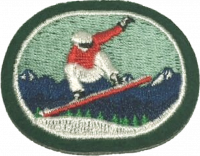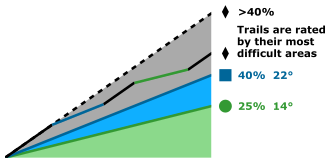AY Honor Snowboarding Answer Key
1
2
2a
2b
2c
2d
2e
2f
In North America, Australia and New Zealand, a color–shape rating system is used to indicate the comparative difficulty of trails (otherwise known as slopes or pistes).
The steepness of ski trails is usually measured by grade (as a percentage) instead of degree angle. In general, beginner slopes (green circle) are between 6% and 25%. Intermediate slopes (blue square) are between 25% and 40%. Difficult slopes (black diamond) are 40% and up. However, this is just a general "rule of thumb". Although slope gradient is the primary consideration in assigning a trail difficulty rating, other factors come into play. A trail will be rated by its most difficult part, even if the rest of the trail is easy. Ski resorts assign ratings to their own trails, rating a trail compared only with other trails at that resort. The resort may take into consideration the width of the trail, sharpest turns, terrain roughness, and whether the trail is groomed regularly.
| Trail Rating | Symbol | Level of difficulty | Description |
|---|---|---|---|
| Green circle | 
|
Easiest | The easiest slopes at a mountain. Generally, Green Circle trails are wide and groomed, with slope grades ranging from 6% to 25%. |
| Blue square | 
|
Intermediate
More Difficult |
Intermediate difficulty slopes. Generally, Intermediate trails are groomed, with grades ranging from 25% to 40%. Blue Square trails make up the bulk of pistes at most ski areas. |
| Black diamond | 
|
Advanced
Most Difficult |
Amongst the most difficult slopes at a mountain. Generally, Black Diamond trails are steep (40% and up) and may or may not be groomed. |
| Double black diamond | 
|
Expert Only
Extremely Difficult |
These trails are even more difficult than Black Diamond, due to exceptionally steep slopes and other hazards such as narrow trails, exposure to wind, and the presence of obstacles such as steep drop-offs or trees. They are intended only for the most experienced skiers.
This trail rating is fairly new; by the 1980s, technological improvements in trail construction and maintenance, coupled with intense marketing competition, led to the creation of a Double Black Diamond rating. |
| Variations | 
|
Various | Variations such as doubling a symbol to indicate increased difficulty, or combining two different symbols to indicate intermediate difficulty are occasionally used, as is often in Colorado at Winter Park resort and other Colorado ski resorts. One example is a diamond overlapping a square to indicate a trail rating between a Blue Square and a Black Diamond, colloquially a 'Blue-Black'. This is used by several eastern resorts, especially in New York with notable examples being at Windham and Hunter Mountain Ski Resort. Many resorts throughout Colorado use a double diamond with an "EX" in the center to mark a run with extreme terrain, even more difficult than a double diamond. Other resorts, such as Smugglers' Notch, Vermont, Le Massif, Quebec, and Mt. Bohemia, Michigan, use triple black diamonds. The combination of symbols is comparatively rare at U.S. ski areas; most ski resorts stick to the standard 4-symbol progression (with the exception of the common EX runs in Colorado).
Non-standard symbols for standard ratings may be encountered at some ski areas. Bogus Basin, a resort near Boise, Idaho, uses orange diamonds on trailhead signs considered to be more difficult than double black diamonds; however, those trails are indicated on the trail map as double black diamonds. Jiminy Peak, MA uses two variations of normal trail ratings; one is a blue square with a green circle inside of it used to represent an easy-intermediate trail. The other is a blue square with a single black diamond in it, used to represent an intermediate-hard trail. |
| Terrain parks | 
|
Various | Terrain parks are whole or portions of trails that can offer a variety of jumps, half-pipes, and other special "extreme" sporting obstacles beyond traditional moguls. The trails are typically represented by an orange rectangle with rounded corners.
Usually, the terrain park will carry its own trail rating, indicating the level of challenge. A terrain park with a Black Diamond or Double Black Diamond rating would contain greater and more challenging obstacles than a park with a Blue Square rating. |
3
The Code states the following:
- Stay in control and avoid other people and hazards.
- Use appropriate protective equipment, especially helmets, to minimise the risk of injury.
- You must have the ability to use each lift safely. If in doubt ask the lift attendant.
- Obey all signs and warnings, and keep off closed trails and areas.
- It is your responsibility to avoid and give way to people below and beside you.
- Do not stop where you are not visible from above or where you obstruct a trail.
- Before starting downhill, or merging into a trail, look uphill and give way to others.
- Use care to prevent runaway snowboards.
- If you are involved in or see an accident, alert and identify yourself to Resort Staff.
- Be aware that it is dangerous to ski, board or ride lifts if your ability is impaired by drugs or alcohol.
More information can be found here
4
4a
4b
4c
4d
4e
4f
5
5a
5b
5c
5d
5e
5f
5g
6
7
8
8a
8b
8c
References




